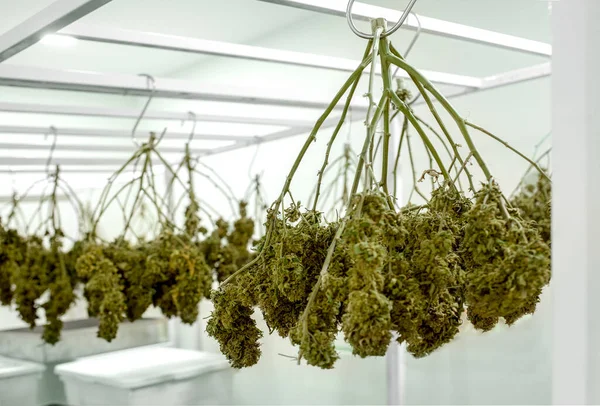Properly drying and curing marijuana buds after harvest is essential for preserving flavors and maximizing their quality. These processes retain valuable compounds like terpenes and cannabinoids while reducing chlorophyll and eliminating the plant’s vegetal taste.
The drying process involves allowing the buds to dry in the open air, resulting in a significant loss of moisture and the removal of sticks, stems, branches, and leaves through trimming.
In dry trimming, the drying occurs first, followed by trimming, while wet trimming involves the reverse order.
It is crucial to find the right balance for drying—neither too quick nor too prolonged—to ensure that the buds are uniformly dried without developing mold.
Once the buds are adequately trimmed and dried, they are carefully stored in airtight containers for the curing process. This stage prevents moisture loss, preserves flavors and aromas, and allows the buds to develop their full and rich taste.
How Long Does It Take To Dry Cannabis?
The drying process for cannabis typically takes around 2 to 7 days. Wet trimming tends to result in a shorter drying time since most of the excess plant material is removed before drying, reducing the overall plant mass.
For dry trimming, it is recommended to hang the harvested plants upside down using a line or hanger. This method, whether for whole plants or branches, helps prevent buds from losing their shape or getting flattened during the drying process.
On the other hand, when employing wet trimming, trimmed buds should be placed on a drying rack.
Regardless of the trimming method used, it is important to regularly check the drying buds or branches. After two days, you can test the readiness by gently bending a branch or stem. If it snaps easily, it indicates that the buds are fully dry. If they don’t snap, give them another day and check again.
How Do I Set Up a Cannabis Drying Room?

Creating an ideal drying room for cannabis is essential for a successful drying process. Here are some factors to consider:
- Lighting and Environment:
- The drying room should be kept dark to protect the cannabis from UV rays, which can degrade its quality. If your space isn’t light-tight, cover the buds appropriately.
- Maintain temperatures within the range of 60-70°F (15-21°C) and humidity levels between 55-65%. A cost-effective hygrometer can help you monitor and regulate these conditions.
- Be aware that controlling temperature and humidity in large rooms can be challenging, so choose a space that allows for easier regulation.
- Ensure the selected room doesn’t experience significant temperature and humidity fluctuations.
- Air Circulation:
- Install a small fan to facilitate air circulation within the drying room. This helps maintain consistent drying conditions and prevents the development of mold or mildew.
- Depending on your specific situation, you might also need to consider using a dehumidifier or air conditioning unit to control humidity levels effectively.
- Drying Room Equipment:
- Utilize a drying rack or line to hang the buds during the drying process. This allows for proper airflow around the buds and helps maintain their shape.
- Employ a hygrometer to measure temperature and humidity accurately.
- Consider the use of additional equipment such as an AC unit or dehumidifier if necessary. These can assist in adjusting the temperature and humidity to facilitate the drying process.
Remember, periodically checking on the buds is acceptable, but limit exposure to prolonged light, as it can accelerate drying and potentially compromise the quality of the cannabis.
Can I Hand Dry Cannabis Buds?
Hanging buds for drying is a less labor-intensive method but requires more space. Here’s how to hang dry buds effectively:
- Preparation:
- Cut off significant branches or consider hanging whole plants upside down. This approach saves time compared to removing individual buds from branches, but keep in mind that it requires more space due to the larger plant volume.
- Drying Duration:
- Understand that hang drying may extend the drying time since more plant matter, such as branches, stems, stalks, and fan leaves, is present. The additional plant material can contribute to a longer drying process.
While hang drying offers convenience and saves time during the initial preparation stage, it’s important to consider the potential trade-off of requiring more space and potentially longer drying times due to the increased plant matter being dried.
How To Dry Buds Without Hanging Them On a Line
If you prefer not to hang your buds on a line for drying, there is an alternative method you can follow. Here’s how to dry buds without hanging them:
- Wet Trimming and Flat Rack:
- When wet trimming, you’ll have numerous individual trimmed buds, making it impractical to hang them. Instead, you’ll need a flat rack, preferably a circular one with mesh layers, to facilitate proper airflow during drying.
- Drying Assessment:
- After placing the wet-trimmed buds on the flat rack, check their dryness after 2-3 days by gently pressing them. If they still feel too moist, it’s best to leave them on the rack and check again the following day.
By using a flat rack and regularly assessing the moisture content of the buds, you can successfully dry them without the need for hanging them on a line.









0 Comments